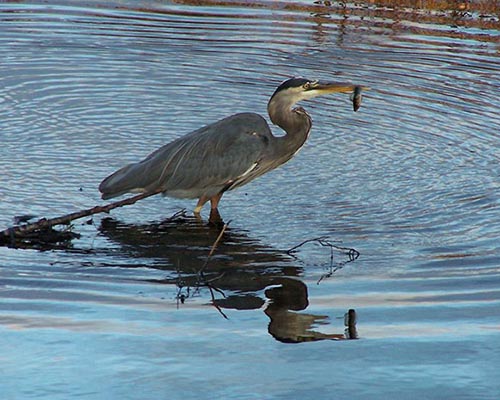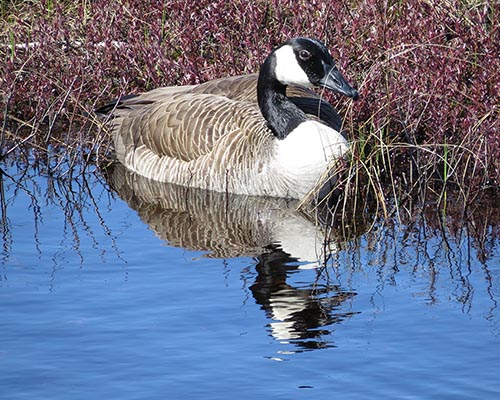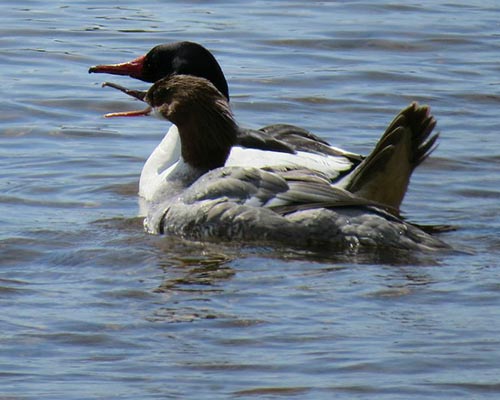The lakes of the Adirondacks are home to a variety of waterbirds that depend upon the lake ecosystems for their habitat and food. There are many different ecological roles that birds can play in lakes. Here, we will look at four waterbird species from three different taxonomic families to explore some of these possible lifestyles.
The great blue heron (Ardea herodiasft) is related to herons, egrets and bitterns. It is a long-legged wading bird that is common along lake shorelines and in wetlands across much of North and Central America. It is the largest North American heron, with a length of up to 4.5 feet and a wingspan of up to 6.5 feet. Despite its size, the average great blue heron in this area weighs only about 5 pounds. Birds have adaptations for flight, such as hollow bones, that make them very light. These herons mainly eat small fish but will eat other small animals such as mice or frogs on occasion. When hunting, they wade very slowly through the water, searching visually for prey with their long neck coiled back and then lunge suddenly, their neck uncoiling like a striking snake, to spear their prey with their long, harpoon-like bill. They eat their prey whole.
The American herring gull (Larus smithsonianus) is part of a family of 55 species of gulls. Ornithologists do not use the term “seagull” since many gulls do not live on or near the ocean. Gulls might be thought of as the trash compactors of the bird world. They will catch small fish and crabs near the water’s surface but will also scavenge upon dead animals and eggs, eat human food and garbage, and steal food from other birds. Gulls have even been observed pecking flesh from the backs of whales when they surface. To assist in these generalist dietary habits, their jaw can unhinge to allow them to eat large prey. They are intelligent and social birds. Some gulls, including the herring gull, have been observed using tools; for example, using bread as bait to catch fish. The herring gull is a medium-sized bird that can grow to slightly over 2 feet long with a wingspan of up to 5 feet.
The Canada goose (Branta canadensis) though once endangered, is now a familiar sight in this part of the world, since, like the herring gull, it is good at living alongside humans and can live in a variety of environments from wetlands to public parks. It is a large bird, up to 3.5 feet long with a wingspan of up to 6 feet. The Canada goose is known for its migratory behavior, forming flocks that honk loudly as they fly. The V-shape of bird flocks such as these is aerodynamic, each bird taking advantage of a corkscrew lift of air — known as tip vortices — produced by the flight of the bird in front of it. The birds take turns in the lead position to spread out the effort. Canada geese are primarily herbivores, eating grasses and aquatic plants, but will also sometimes eat small insects and fish or filter-feed from silt at the bottom of shallow water.
The common merganser (Mergus merganser) is a type of duck. They live near large lakes and rivers, and specialize in eating fish, although they will sometimes eat other food, especially aquatic invertebrates. They are accomplished divers, staying under for up to two minutes (but usually less than 30 seconds). Their bills have serrated edges that grip their prey tightly, leading to their nickname of “sawbills.” Unlike the other bird species shown here, the common merganser exhibits pronounced sexual dimorphism, a difference in appearance between male and females.
The common loon is discussed at the Climate Change station.



